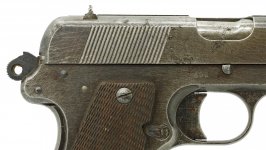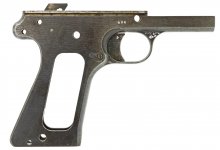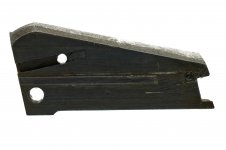Absolut
Senior Member
This one keeps me scratching my head .. it is an all matching numbers VIS Radom with a 1939 dating slide (last two digits of the pistol were digitally removed in the pictures). The serial places it right at the end of Polish production and when Germany invaded Poland. The pistol is void of any German markings, except the matching numbers barrel (with the last three digits of the pistol) carrying a Eagle 623 acceptance - these digits in the place where the Germans placed the serial number on the barrel! What is also extremely odd is the fact the Finish is not the very high quality Polish blueing one can find on these pistols. Additionally, the frame is EXTREMELY rough on the outside. The backside is full of file markings, almost as originally it was never finished. And finally, the grips (worth pointing out: the top screw is different from the bottom screw; top screw has a flatter surface so that it doesn't stick out this much) are wooden grips with full checkering.
The only possible explanation to myself was that these were left-over scrap parts from Poland that in 1945 at Steyr were completed with a barrel and whatever replacement grips were at hand. Looking up in the VIS Radom book by William J. York I also could not find any answer, so any input is highly appreciated.
PS: I had a good laugh on notes being stamped on the right side of the frame on the trigger guard. Makes one really wonder why someone would use such a stamp on a gun..
The only possible explanation to myself was that these were left-over scrap parts from Poland that in 1945 at Steyr were completed with a barrel and whatever replacement grips were at hand. Looking up in the VIS Radom book by William J. York I also could not find any answer, so any input is highly appreciated.
PS: I had a good laugh on notes being stamped on the right side of the frame on the trigger guard. Makes one really wonder why someone would use such a stamp on a gun..
Attachments
-
 VIS1939_01.jpg294 KB · Views: 80
VIS1939_01.jpg294 KB · Views: 80 -
 VIS1939_02.jpg291.6 KB · Views: 66
VIS1939_02.jpg291.6 KB · Views: 66 -
 VIS1939_03.jpg310.1 KB · Views: 65
VIS1939_03.jpg310.1 KB · Views: 65 -
 VIS1939_04.jpg228.5 KB · Views: 41
VIS1939_04.jpg228.5 KB · Views: 41 -
 VIS1939_05.jpg234.2 KB · Views: 49
VIS1939_05.jpg234.2 KB · Views: 49 -
 VIS1939_06.jpg302.8 KB · Views: 45
VIS1939_06.jpg302.8 KB · Views: 45 -
 VIS1939_07.jpg235.5 KB · Views: 42
VIS1939_07.jpg235.5 KB · Views: 42 -
 VIS1939_08.jpg267.7 KB · Views: 39
VIS1939_08.jpg267.7 KB · Views: 39 -
 VIS1939_09.jpg174.8 KB · Views: 34
VIS1939_09.jpg174.8 KB · Views: 34 -
 VIS1939_10.jpg196 KB · Views: 35
VIS1939_10.jpg196 KB · Views: 35 -
 VIS1939_11.jpg214.1 KB · Views: 40
VIS1939_11.jpg214.1 KB · Views: 40 -
 VIS1939_12.jpg175.9 KB · Views: 32
VIS1939_12.jpg175.9 KB · Views: 32 -
 VIS1939_13.jpg233.2 KB · Views: 35
VIS1939_13.jpg233.2 KB · Views: 35 -
 VIS1939_14.jpg262.1 KB · Views: 35
VIS1939_14.jpg262.1 KB · Views: 35 -
 VIS1939_15.jpg170.4 KB · Views: 30
VIS1939_15.jpg170.4 KB · Views: 30











